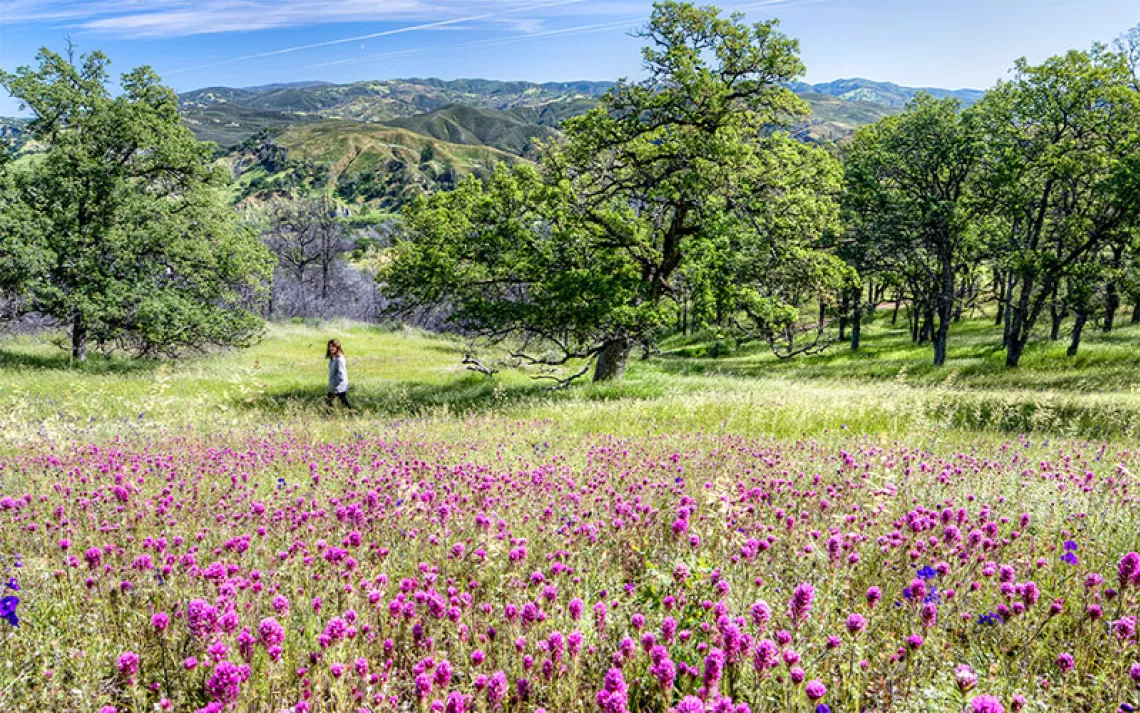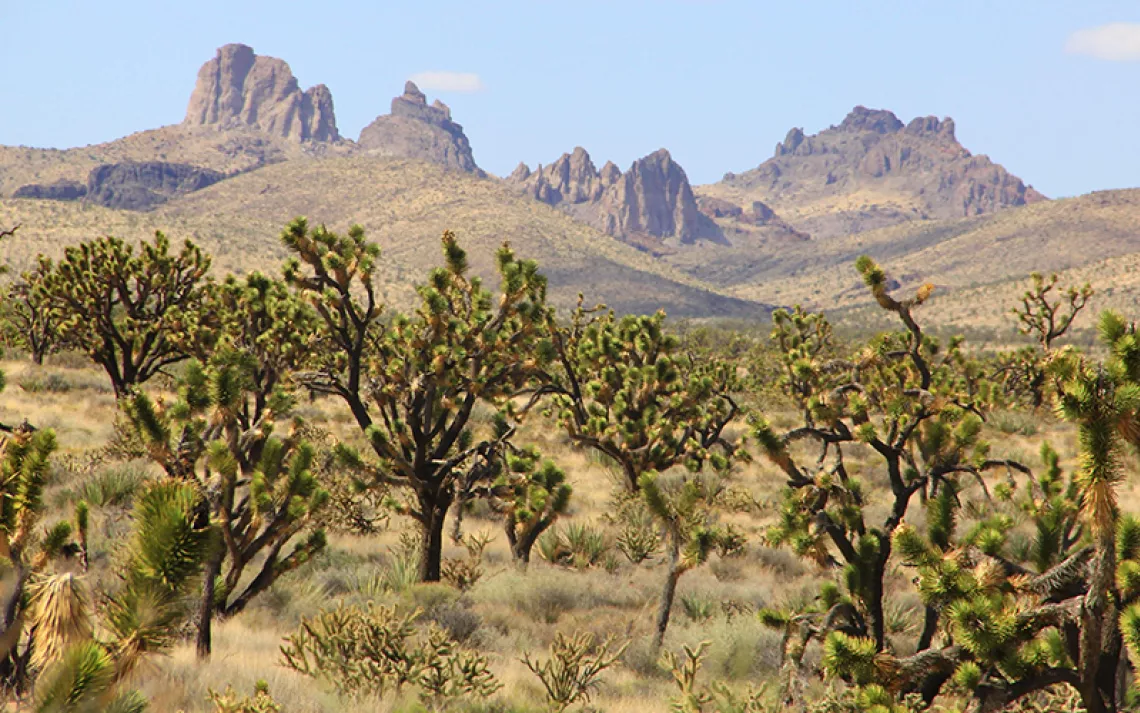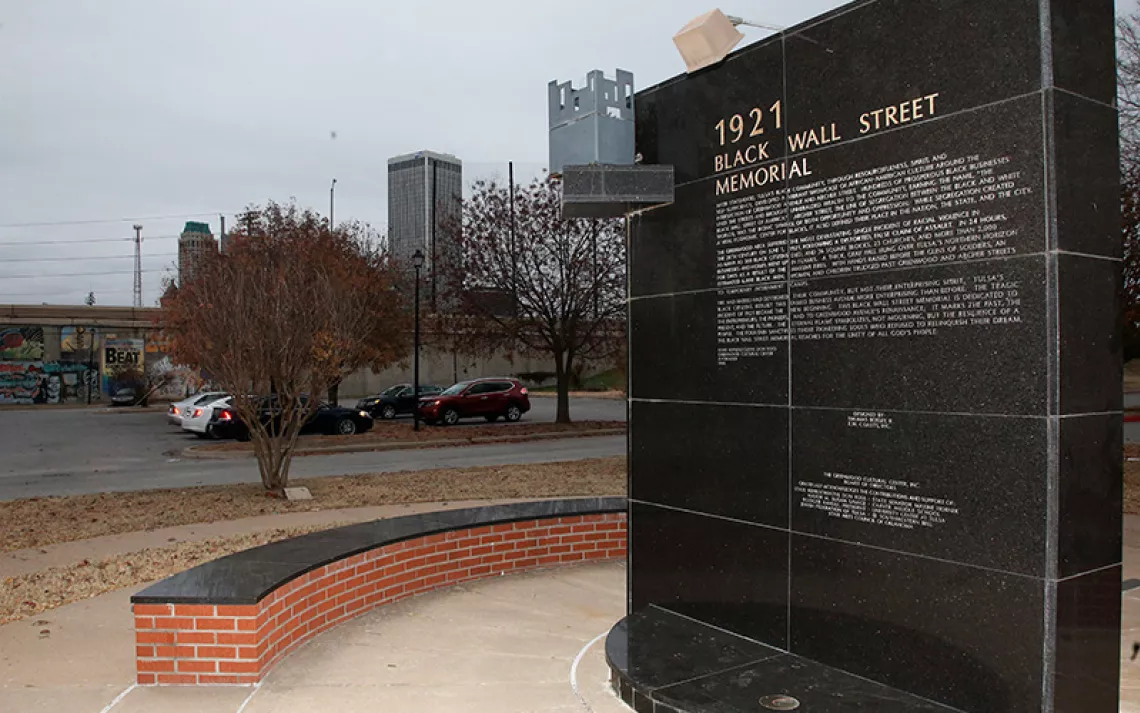President Biden Establishes the Springfield Race Riot National Monument
New NPS site will commemorate the 1908 Illinois tragedy that marked a turning point in American race relations

A portion of Preston Jackson's 2009 Acts of Intolerance statue in Springfield, Illinois's Union Square. The statue, in the form of two chimney columns that are all that remains from a burned-out building, commemorates the deadly Springfield race riot of 1908, in which white mobs attacked African American residents, burned several homes, and lynched two black men. | Photo courtesy of Carol M. Highsmith America Library of Congress Collection
President Biden on Friday designated the country’s newest national monument in Springfield, Illinois, fulfilling requests made by state leaders and environmental-justice advocates early in the president’s term. The new Springfield 1908 Race Riot National Monument commemorates the area where a hoard of thousands of white residents terrorized and vandalized a predominately Black section of Illinois’s capital, which involved the burning of over three dozen homes and businesses and the deaths of 17 people.
The president signed the designation into law in the Oval Office, surrounded by civil rights leaders and advocates during the 116th commemoration of the riot.
“The new national monument will tell the story of a horrific attack by a white mob on a Black community that was representative of the racism, intimidation, and violence that Black Americans experienced across the country,” read a White House statement put out on Friday morning. “The Springfield 1908 Race Riot National Monument weaves together two important threads in our nation’s story: the hateful violence targeted against Black Americans and the power of dedicated individuals to come together across racial lines to transform shock and grief into hope and action.”
The new monument covers approximately 1.5 acres across several city blocks of the neighborhood where the riot took place and protects archaeological sites that include artifacts such as personal items and building remnants, which were uncovered in 2014 after the city kickstarted plans to construct a railway underpass beneath one of the sites.
Civil rights and environmental advocates, including the members of the local chapters of the Sierra Club and the American Civil Liberties Union (ACLU), welcomed the news. Nick Dodson, the chair of the Sangamon Valley Group of the Sierra Club, says the measure is long overdue, especially since many of the city’s white residents have little idea that the riots took place.
“We are one of the most segregated cities in the United States of America,” said Dodson, who has been a part of grassroots efforts to designate a national monument since 2019. “I think that having conversations and monuments that explain the tumultuous past can maybe help people understand how recent it really was and how the implications of those riots still affect our Black and brown sisters and brothers in Springfield still to this day.”
The legacy of the riots can be seen in how Black residents have been pushed to the east side of the city, where many still live today. According to Ken Page, the president of the Springfield chapter of the ACLU, Black residents are more likely to deal with discriminatory housing issues, unequal access to jobs, and aggressive policing. Just last month, a Black resident named Sonya Massey was shot in her own home by a white sheriff’s deputy after her mom called the police to check on her.
For many organizers, the designation represents a pivotal moment. “I'm hopeful that Springfield will live up to Lincoln's legacy,” Page said, referring to the 16th president, who spent much of his adulthood in the city. “You're going to have a national monument here that deals with something that happened so horrible in the city that you would not be able to hide anymore.”
Work to protect the area has been decades in the making. In the 1990s, local resident Velma Carey began discussions with the mayor to create historical markers identifying particularly poignant locations related to the riots. Around that same time, two white sixth graders, Amanda Staab and Lindsay Harney, advocated for the creation of a memorial. But momentum picked up following the discovery of the artifacts a decade ago.
Recognizing the significance of the find, former US representative Rodney Davis, a Republican, introduced legislation in 2018 directing the National Park Service to study the feasibility of creating a national park. In 2019, Senators Tammy Duckworth and Dick Durban, both Democrats, introduced further legislation to add the area to the national park system, something the two have done every legislative session since. Representatives on the House side introduced companion legislations last year. Seeing the bill go nowhere in Congress, the senators then asked President Biden to use the power afforded to him by the Antiquities Act to designate a new national monument. The law gives presidents broad authority to preserve existing public land or donated land or property that is culturally, ecologically, or historically significant.
The Biden administration and leaders at the Interior Department, which oversees the management of national monuments, have long supported the effort to create a national monument in Springfield. Just last year, the National Park Service announced the results of its feasibility study, which concluded that the area meets all the requirements to be considered a national historic site. In June, Brenda Mallory, chair of the White House Council on Environmental Quality, and Assistant Interior Secretary Shannon Estenoz visited Springfield to hear from community members on what they envision for the site. During many of the speeches on the potential designation, several leaders made a point of honoring not just the good parts of American history but also the bad.

Sign up to receive Sierra News & Views
Get articles like this one sent directly to your inbox weekly.
With this action you affirm you want to receive Sierra Club communications and may vote on policy designated by the Sierra Club Board.
“These sites represent difficult moments of our nation's past,” Mallory said during her visit to Springfield. “They also serve today as an important reminder of a life we do not want to relive in our fight towards justice.”

Photo courtesy of Carol M. Highsmith America Library of Congress Collection
The riot was sparked by the account of Mabel Hallam, a 21-year-old white women, who accused George Richardson, a Black man, of raping her. But many historians point to simmering white resentment of Black residents who had done well for themselves. Many of them had purchased homes, owned businesses, and worked in positions of authority.
Richardson was subsequently arrested and placed in a cell with Joe James, a man who was accused of murdering a white man a week before the riot. Once in custody, the two men became targets for a mob of white residents who thought they’d avenge the assumed victims with vigilante justice. When officers got wind of the plan, they snuck the two men out of the jail and moved them to a safer location in nearby Bloomington. Enraged by the transfer, the resident inflicted vengeance on the town. Hallam eventually recanted her story, vindicating Richardson. It turned out she was having an affair with a white man that she was hoping to cover up. (James was charged with the unrelated murder and later hanged.)
The horrendous acts proved to be pivotal for race relations in the United States. The destruction and callous savagery drew the attention of the entire nation, with journalists from around the country racing to Springfield to document the events. The hatred was on full display in the photos and accounts of witnesses for the world to see and hear. Their stories garnered the attention of major journalists and activists such as Ida B. Wells and W.E.B. du Bois. Their advocacy and work with other community leaders in the aftermath of the riot served as the catalyst for the creation of the NAACP, which has consistently supported the designation of a national monument.
“Memorializing places like Springfield is especially important today because we literally are witnessing the erosion of teaching of Black history in schools and in the public sphere,” Cedric Haynes, the vice president of policy and legislative affairs at the NAACP, said. “I think that when we preserve these sites, we ensure that future generations understand the full scope of our nation's history, including the struggles and contributions of Black Americans.”
 The Magazine of The Sierra Club
The Magazine of The Sierra Club



